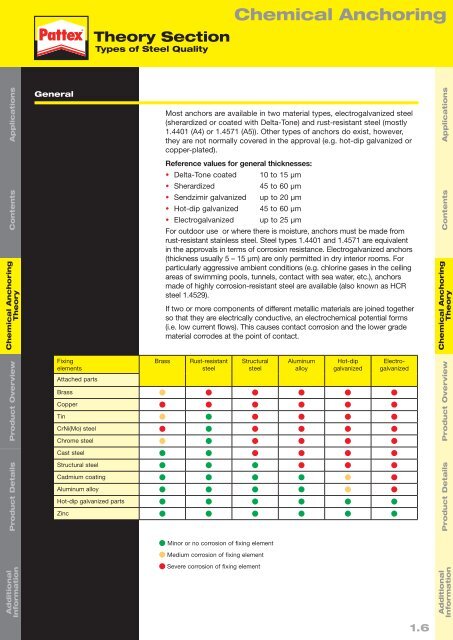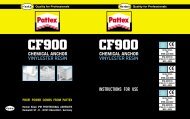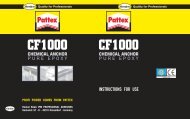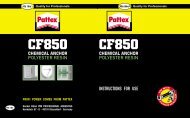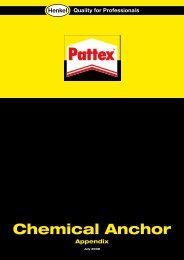Chemical Anchor Technical Handbook
Chemical Anchor Technical Handbook
Chemical Anchor Technical Handbook
You also want an ePaper? Increase the reach of your titles
YUMPU automatically turns print PDFs into web optimized ePapers that Google loves.
Theory Section<br />
Types of Steel Quality<br />
<strong>Chemical</strong> <strong>Anchor</strong>ing<br />
Contents Applications<br />
<strong>Chemical</strong> <strong>Anchor</strong>ing<br />
Theory<br />
Product Overview<br />
General<br />
Fixing<br />
elements<br />
Attached parts<br />
Brass<br />
Copper<br />
Tin<br />
CrNi(Mo) steel<br />
Chrome steel<br />
Most anchors are available in two material types, electrogalvanized steel<br />
(sherardized or coated with Delta-Tone) and rust-resistant steel (mostly<br />
1.4401 (A4) or 1.4571 (A5)). Other types of anchors do exist, however,<br />
they are not normally covered in the approval (e.g. hot-dip galvanized or<br />
copper-plated).<br />
Reference values for general thicknesses:<br />
• Delta-Tone coated 10 to 15 µm<br />
• Sherardized 45 to 60 µm<br />
• Sendzimir galvanized up to 20 µm<br />
• Hot-dip galvanized 45 to 60 µm<br />
• Electrogalvanized up to 25 µm<br />
For outdoor use or where there is moisture, anchors must be made from<br />
rust-resistant stainless steel. Steel types 1.4401 and 1.4571 are equivalent<br />
in the approvals in terms of corrosion resistance. Electrogalvanized anchors<br />
(thickness usually 5 – 15 µm) are only permitted in dry interior rooms. For<br />
particularly aggressive ambient conditions (e.g. chlorine gases in the ceiling<br />
areas of swimming pools, tunnels, contact with sea water, etc.), anchors<br />
made of highly corrosion-resistant steel are available (also known as HCR<br />
steel 1.4529).<br />
If two or more components of different metallic materials are joined together<br />
so that they are electrically conductive, an electrochemical potential forms<br />
(i.e. low current flows). This causes contact corrosion and the lower grade<br />
material corrodes at the point of contact.<br />
Brass<br />
Rust-resistant<br />
steel<br />
Structural<br />
steel<br />
Aluminum<br />
alloy<br />
Hot-dip<br />
galvanized<br />
Product Details<br />
Additional<br />
Information<br />
Electro -<br />
galva nized<br />
Product Overview<br />
<strong>Chemical</strong> <strong>Anchor</strong>ing<br />
Theory<br />
Contents Applications<br />
Cast steel<br />
Product Details<br />
Additional<br />
Information<br />
Structural steel<br />
Cadmium coating<br />
Aluminum alloy<br />
Hot-dip galvanized parts<br />
Zinc<br />
Minor or no corrosion of fixing element<br />
Medium corrosion of fixing element<br />
Severe corrosion of fixing element<br />
1.6


